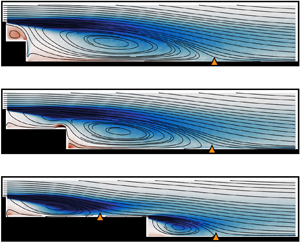Article contents
The double backward-facing step: interaction of multiple separated flow regions
Published online by Cambridge University Press: 15 February 2022
Abstract

The backward-facing step is perhaps the quintessential geometry used to study separated flow. Extensive previous research has quantified its detailed flow characteristics. However, often regions of separated flow do not exist in isolation; rather, interaction occurs between multiple regions. This motivated an experimental investigation into the time-averaged and dynamic flow features of a double backward-facing step, covering separations of zero to eight step heights between equal-height steps. Three flow regimes are identified. A single reattachment regime occurs for separations of less than four step heights, perhaps remarkable for the lack of variation in key flow characteristics from a single backward-facing step response. Next, an intermediate regime is identified for a separation of four step heights. In this case, the flow does not yet reattach on the first step, although significant differences in reattachment length, surface pressure on the vertical step faces and turbulence statistics occur. Finally, for greater step separations, a double reattachment regime, with reattachment on both steps, is identified. Downwash, induced by the first recirculation zone, reduces the reattachment length and turbulent fluctuations of the second recirculation zone. The surface pressure on the first-step vertical face is reduced, seemingly a result of an upstream influence due to the low pressure in the second-step recirculation zone. Detailed characterisation of the regimes offers insight into the fundamental interaction of regions of separated flow, revealing aspects of complex dynamics relevant to a broad range of practical scenarios.
JFM classification
- Type
- JFM Papers
- Information
- Copyright
- © The Author(s), 2022. Published by Cambridge University Press
References
REFERENCES
- 5
- Cited by





